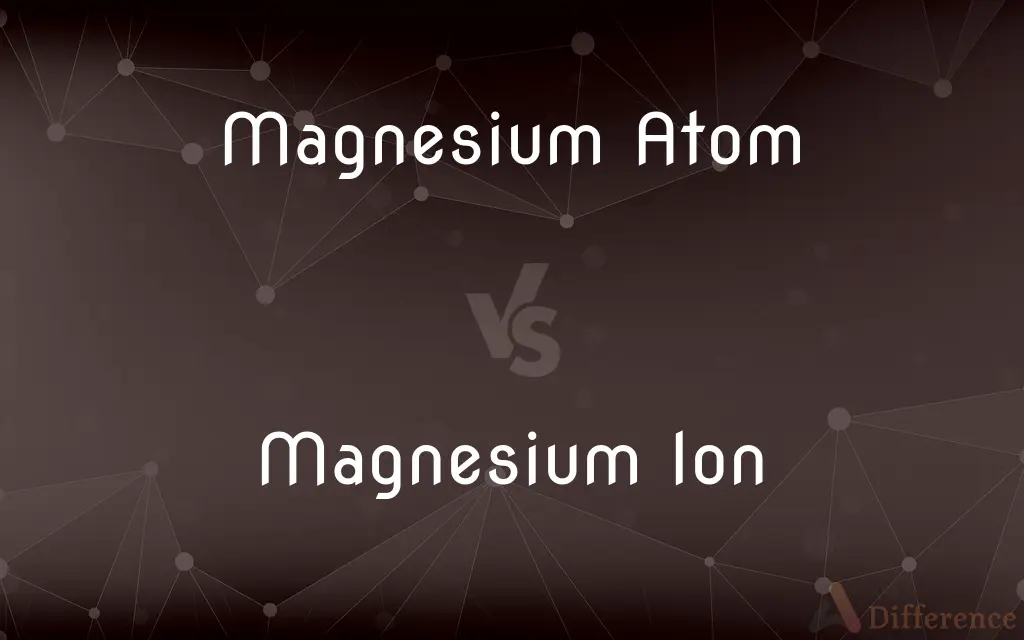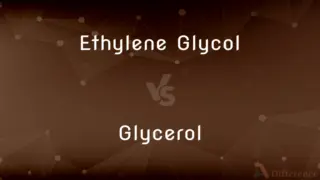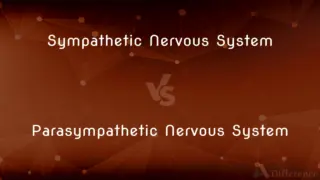Magnesium Atom vs. Magnesium Ion — What's the Difference?
By Tayyaba Rehman — Published on January 18, 2024
A Magnesium Atom is a neutral entity with an equal number of protons and electrons, while a Magnesium Ion is charged, typically losing two electrons to become positively charged.

Difference Between Magnesium Atom and Magnesium Ion
Table of Contents
ADVERTISEMENT
Key Differences
A Magnesium Atom is the basic unit of the element Magnesium, consisting of 12 protons, 12 neutrons, and 12 electrons, making it electrically neutral. A Magnesium Ion, particularly a Magnesium cation (Mg^2+), is formed when a Magnesium atom loses two electrons, resulting in a positively charged entity with 12 protons and only 10 electrons.
The neutral Magnesium Atom is found in its elemental form and is relatively reactive, especially with acids. The Magnesium Ion, with a 2+ charge, is a stable ion commonly found in various compounds and is significant in biological systems, especially in chlorophyll in plants.
In terms of chemical behavior, a Magnesium Atom can easily lose two electrons to form a Magnesium Ion, which is a typical reaction in the formation of Magnesium compounds. The Magnesium Ion is less reactive than the atom and usually participates in ionic bonding to form compounds like Magnesium Oxide (MgO) or Magnesium Chloride (MgCl2).
The physical properties of a Magnesium Atom and a Magnesium Ion differ significantly. While Magnesium atoms make up the solid metal magnesium, Magnesium ions are usually found in aqueous solutions or as part of ionic compounds.
The presence of a Magnesium Atom is typical in metallic Magnesium, used in various applications from aircraft manufacturing to fireworks. Magnesium Ions, on the other hand, play crucial roles in biological systems, industrial processes, and are found in many minerals.
ADVERTISEMENT
Comparison Chart
Charge
Neutral (equal protons and electrons).
Positively charged (loses two electrons).
Composition
12 protons, 12 neutrons, 12 electrons.
12 protons, 12 neutrons, 10 electrons.
Reactivity
Reactive in elemental form.
Less reactive, stable in ionic form.
Occurrence
In elemental Magnesium.
In compounds and biological systems.
Role and Use
Basic unit of element, used in manufacturing.
Important in biological functions, forms compounds.
Compare with Definitions
Magnesium Atom
A Magnesium Atom is the smallest unit of elemental Magnesium, consisting of 12 protons, 12 neutrons, and 12 electrons.
In its elemental state, Magnesium exists as Magnesium atoms.
Magnesium Ion
A Magnesium Ion typically refers to Mg^2+, formed by losing two electrons.
In Magnesium chloride, each Magnesium atom forms a Mg^2+ ion.
Magnesium Atom
The atomic number of a Magnesium Atom is 12.
A Magnesium atom has 12 protons in its nucleus.
Magnesium Ion
Often found in ionic compounds and in aqueous solutions.
Magnesium ions are abundant in seawater.
Magnesium Atom
Magnesium Atoms are the building blocks of Magnesium metal.
Pure Magnesium is composed of closely packed Magnesium atoms.
Magnesium Ion
Magnesium Ions are crucial in biological processes, including photosynthesis.
Magnesium ions are central to the chlorophyll molecule in plants.
Magnesium Atom
It is electrically neutral with an equal number of protons and electrons.
Each Magnesium atom in the metal lattice is electrically neutral.
Magnesium Ion
Magnesium Ions have a stable electronic configuration.
The stability of Magnesium ions makes them less reactive than the atoms.
Magnesium Atom
A Magnesium Atom can react and form compounds by losing electrons.
Magnesium atoms react with oxygen to form Magnesium oxide.
Magnesium Ion
It is positively charged due to an imbalance between protons and electrons.
The positive charge of the Magnesium ion plays a role in ionic bonding.
Common Curiosities
What's the difference between a Magnesium Atom and Ion?
A Magnesium Atom is neutral, while a Magnesium Ion carries a positive charge due to loss of electrons.
How is a Magnesium Ion formed from a Magnesium Atom?
When a Magnesium Atom loses two electrons, it becomes a positively charged Magnesium Ion (Mg^2+).
Where do you typically find Magnesium Ions?
Magnesium Ions are commonly found in ionic compounds and biological systems.
Can a Magnesium Atom exist independently?
Yes, Magnesium Atoms exist independently in elemental Magnesium, but they are quite reactive.
Are Magnesium Ions larger than Magnesium Atoms?
No, Magnesium Ions are actually smaller due to the loss of two outermost electrons.
Why is the Magnesium Ion more stable than the Magnesium Atom?
The Magnesium Ion is more stable due to its full outer electron shell after losing two electrons.
What role do Magnesium Ions play in the body?
Magnesium Ions are vital for numerous biological processes, including nerve function and energy production.
What is the electronic configuration of a Magnesium Ion?
A Magnesium Ion has an electronic configuration of 2,8, after losing two electrons.
Do Magnesium Atoms have a role in manufacturing?
Magnesium Atoms are fundamental in manufacturing Magnesium metal, used in various industries.
What is the charge of a typical Magnesium Ion?
A typical Magnesium Ion, Mg^2+, carries a 2+ positive charge.
Can Magnesium Atoms form molecules?
Yes, Magnesium Atoms can bond with other elements to form molecules, like Magnesium Oxide.
Is the Magnesium Ion important in industrial processes?
Yes, Magnesium Ions are used in various industrial applications, including water treatment.
Are Magnesium Ions always positively charged?
Yes, Magnesium Ions in compounds are positively charged, typically as Mg^2+.
How does the reactivity of Magnesium Atoms compare to Magnesium Ions?
Magnesium Atoms are more reactive than Magnesium Ions, which are more stable.
How does the size of a Magnesium Ion affect its properties?
The smaller size of the Magnesium Ion affects its ionic radius and chemical reactivity.
Share Your Discovery

Previous Comparison
Ethylene Glycol vs. GlycerolAuthor Spotlight
Written by
Tayyaba RehmanTayyaba Rehman is a distinguished writer, currently serving as a primary contributor to askdifference.com. As a researcher in semantics and etymology, Tayyaba's passion for the complexity of languages and their distinctions has found a perfect home on the platform. Tayyaba delves into the intricacies of language, distinguishing between commonly confused words and phrases, thereby providing clarity for readers worldwide.














































